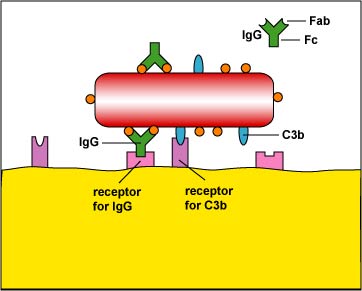Fig. 2: Enhanced Attachment of
Bacteria to Phagocytes

One of the functions
of certain antibody molecules known as IgG is to stick antigens such as bacterial
proteins and polysaccharides to phagocytes. The tips of the antibody,
the Fab portion, have a shape that fits epitopes, portions of an antigen with
a complementary shape. The stalk of the antibody is called the
Fc portion and is able to bind to Fc receptors on phagocytes. Also, when body
defense pathways known as the complement pathways are activated, one of the
beneficial defense proteins made is called C3b. C3b binds by one end to bacterial
surface proteins and by the other end to C3b receptors on phagocytes. The
IgG and C3b are also known as opsonins and the process of enhanced attachment
is also called opsonization.
Illustration of Enhanced Attachment of
Bacteria to Phagocytes.jpg by Gary E. Kaiser, Ph.D.
Professor of Microbiology,
The Community College of Baltimore County, Catonsville Campus
This work is licensed under a Creative Commons Attribution 4.0 International License.
Based on a work at https://cwoer.ccbcmd.edu/science/microbiology/index_gos.html.

Last updated:October, 2018
Please send comments and inquiries to Dr.
Gary Kaiser
